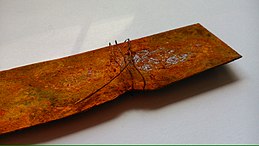Iron oxide
Iron oxides are chemical compounds composed of iron and oxygen. Several iron oxides are recognized. All are black magnetic solids. Often they are non-stoichiometric. Oxyhydroxides are a related class of compounds, perhaps the best known of which is rust.[1]
Iron oxides and oxyhydroxides are widespread in nature and play an important role in many geological and biological processes. They are used as iron ores, pigments, catalysts, and in thermite, and occur in hemoglobin. Iron oxides are inexpensive and durable pigments in paints, coatings and colored concretes. Colors commonly available are in the "earthy" end of the yellow/orange/red/brown/black range. When used as a food coloring, it has E number E172.
Stoichiometries[edit]
Iron oxides feature as ferrous (Fe(II)) or ferric (Fe(III)) or both. They adopt octahedral or tetrahedral coordination geometry. Only a few oxides are significant at the earth's surface, particularly wüstite, magnetite, and hematite.
- Oxides of FeII
- FeO: iron(II) oxide, wüstite
- Mixed oxides of FeII and FeIII
- Oxide of FeIII
- Fe2O3: iron(III) oxide
- α-Fe2O3: alpha phase, hematite
- β-Fe2O3: beta phase
- γ-Fe2O3: gamma phase, maghemite
- ε-Fe2O3: epsilon phase
- Fe2O3: iron(III) oxide
Thermal expansion[edit]
| Iron oxide | CTE (× 10−6 °C−1) |
|---|---|
| Fe2O3 | 14.9[6] |
| Fe3O4 | >9.2[6] |
| FeO | 12.1[6] |
Oxide-hydroxides[edit]
- goethite (α-FeOOH),
- akaganéite (β-FeOOH),
- lepidocrocite (γ-FeOOH),
- feroxyhyte (δ-FeOOH),
- ferrihydrite (Fe5HO8 · 4 H2O approx., or 5 Fe2O3 · 9 H2O, better recast as FeOOH · 0.4 H2O)
- high-pressure pyrite-structured FeOOH.[7] Once dehydration is triggered, this phase may form FeO2Hx (0 < x < 1).[8]
- green rust (FeScript error: No such module "Su".FeScript error: No such module "Su".OH3x + y − z (A−)z where A− is Cl− or 0.5 SO2−
4)
Reactions[edit]
In blast furnaces and related factories, iron oxides are converted to the metal. Typical reducing agents are various forms of carbon. A representative reaction starts with ferric oxide:[9]
- 2 Fe
2O
3 + 3 C → 4 Fe + 3 CO
2
In nature[edit]
Iron is stored in many organisms in the form of ferritin, which is a ferrous oxide encased in a solubilizing protein sheath.[10]
Species of bacteria, including Shewanella oneidensis, Geobacter sulfurreducens and Geobacter metallireducens, use iron oxides as terminal electron acceptors.[11]
Uses[edit]
Almost all iron ores are oxides, so in that sense these materials are important precursors to iron metal and its many alloys.
Iron oxides are important pigments, coming in a variety of colors (black, red, yellow). Among their many advantages, they are inexpensive, strongly colored, and nontoxic.[12]
Magnetite is a component of magnetic recording tapes.
See also[edit]
References[edit]
- ↑ Cornell., RM.; Schwertmann, U (2003). The iron oxides: structure, properties, reactions, occurrences and. Wiley VCH. ISBN 978-3-527-30274-1.
- ↑ Lavina, B.; Dera, P.; Kim, E.; Meng, Y.; Downs, R. T.; Weck, P. F.; Sutton, S. R.; Zhao, Y. (Oct 2011). "Discovery of the recoverable high-pressure iron oxide Fe4O5". Proceedings of the National Academy of Sciences. 108 (42): 17281–17285. Bibcode:2011PNAS..10817281L. doi:10.1073/pnas.1107573108. PMC 3198347. PMID 21969537.
- ↑ Lavina, Barbara; Meng, Yue (2015). "Synthesis of Fe5O6". Science Advances. 1 (5): e1400260. doi:10.1126/sciadv.1400260. PMC 4640612. PMID 26601196.
- ↑ 4.0 4.1 Bykova, E.; Dubrovinsky, L.; Dubrovinskaia, N.; Bykov, M.; McCammon, C.; Ovsyannikov, S. V.; Liermann, H. -P.; Kupenko, I.; Chumakov, A. I.; Rüffer, R.; Hanfland, M.; Prakapenka, V. (2016). "Structural complexity of simple Fe2O3 at high pressures and temperatures". Nature Communications. 7: 10661. doi:10.1038/ncomms10661. PMC 4753252. PMID 26864300.
- ↑ Merlini, Marco; Hanfland, Michael; Salamat, Ashkan; Petitgirard, Sylvain; Müller, Harald (2015). "The crystal structures of Mg2Fe2C4O13, with tetrahedrally coordinated carbon, and Fe13O19, synthesized at deep mantle conditions". American Mineralogist. 100 (8–9): 2001–2004. doi:10.2138/am-2015-5369. S2CID 54496448.
- ↑ 6.0 6.1 6.2 Fakouri Hasanabadi, M.; Kokabi, A.H.; Nemati, A.; Zinatlou Ajabshir, S. (February 2017). "Interactions near the triple-phase boundaries metal/glass/air in planar solid oxide fuel cells". International Journal of Hydrogen Energy. 42 (8): 5306–5314. doi:10.1016/j.ijhydene.2017.01.065. ISSN 0360-3199.
- ↑ Nishi, Masayuki; Kuwayama, Yasuhiro; Tsuchiya, Jun; Tsuchiya, Taku (2017). "The pyrite-type high-pressure form of FeOOH". Nature. 547 (7662): 205–208. doi:10.1038/nature22823. ISSN 1476-4687. PMID 28678774. S2CID 205257075.
- ↑ Hu, Qingyang; Kim, Duckyoung; Liu, Jin; Meng, Yue; Liuxiang, Yang; Zhang, Dongzhou; Mao, Wendy L.; Mao, Ho-kwang (2017). "Dehydrogenation of goethite in Earth's deep lower mantle". Proceedings of the National Academy of Sciences. 114 (7): 1498–1501. doi:10.1073/pnas.1620644114. PMC 5320987. PMID 28143928.
- ↑ Template:Greenwood&Earnshaw2nd
- ↑ Honarmand Ebrahimi, Kourosh; Hagedoorn, Peter-Leon; Hagen, Wilfred R. (2015). "Unity in the Biochemistry of the Iron-Storage Proteins Ferritin and Bacterioferritin". Chemical Reviews. 115 (1): 295–326. doi:10.1021/cr5004908. PMID 25418839.
- ↑ Bretschger, O.; Obraztsova, A.; Sturm, C. A.; Chang, I. S.; Gorby, Y. A.; Reed, S. B.; Culley, D. E.; Reardon, C. L.; Barua, S.; Romine, M. F.; Zhou, J.; Beliaev, A. S.; Bouhenni, R.; Saffarini, D.; Mansfeld, F.; Kim, B.-H.; Fredrickson, J. K.; Nealson, K. H. (20 July 2007). "Current Production and Metal Oxide Reduction by Shewanella oneidensis MR-1 Wild Type and Mutants". Applied and Environmental Microbiology. 73 (21): 7003–7012. doi:10.1128/AEM.01087-07. PMC 2223255. PMID 17644630.
- ↑ Template:Ullmann



